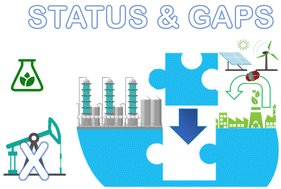Status and gaps toward fossil-free sustainable chemical production†
Abstract
Chemical production needs to transform radically toward fossil-free sustainable chemical production to meet the targets for net-zero emissions by the year 2050. The feasibility of this transformation, the motivations, status and gaps, and perspectives are discussed after introducing how this change also implies a change in the model of production. Realizing the defossilization of chemical production involves electrifying the chemical processes, especially crucial elements such as chemical reactors, and the direct use of renewable energy to drive the chemical reaction. With a focus on electrocatalysis, the most relevant cases of (i) light olefin production, (ii) direct synthesis of main intermediates such as formaldehyde and acetic acid, and (iii) the production of aromatics are analyzed. The feasibility of these routes in the short–medium term is shown, while other cases such as the direct synthesis of ammonia from N2 require turning the approach to other directions. On a global scale, defossilization of chemical production is feasible in the medium–long term with a cut of over 800 Mt per year CO2 eq. emissions in line with the expectation to reach the net-zero emission target. A final section introduces a short discussion about some critical questions regarding the sustainability of fossil-free chemical production.

- This article is part of the themed collection: Green Chemistry Reviews


 Please wait while we load your content...
Please wait while we load your content...